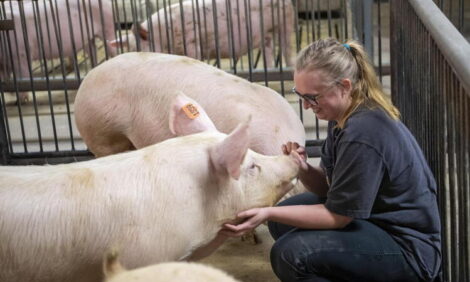



USDA Quarterly Pigs and Hogs Report: December 2005
This quarter's quarterly Hogs and Pigs report from the USDA's National Agricultural Statistics Service. The article provides the report text and graphs, and helps explain what it all means. Link also to the full PDF report.Introduction
This document aims to pull together, in one place of reference, all the various information generated by the USDA Quarterly report. This document includes:
USDA Quarterly report: December 2005What it all means - expert commentary
In the News - what the media says
Graph data from the report Hog Inventories by State (external link - select State and navigate to file)
For a PRINTABLE VERSION of the full 27 page report in PDF format, including all the tabular data which is not shown in this article, Click Here
US Quarterly Pigs and Hogs Inventory: December 2005
U.S. inventory of all hogs and pigs on December 1, 2005 was 61.2 million head. This was up slightly from December 1, 2004, but down 1 percent from September 1, 2005.
Breeding inventory, at 6.01 million head, was up 1 percent from last year and last quarter. Market hog inventory, at 55.2 million head, was up slightly from last year but down 1 percent from last quarter.
The September-November 2005 U.S. pig crop, at 26.1 million head, was up 1 percent from 2004 and up 2 percent from 2003. Sows farrowing during this period totaled 2.89 million head, unchanged from last year.
The sows farrowed during this quarter represented 48 percent of the breeding herd.
The average pigs saved per litter was 9.03 for the September-November 2005 period, compared to 8.96 last year.
Pigs saved per litter by size of operation ranged from 7.50 for operations with 1-99 hogs and pigs to 9.10 for operations with more than 5,000 hogs and pigs.
US Quarterly Pigs and Hogs Inventory: December 1

U.S. hog producers intend to have 2.88 million sows farrow during the December 2005-February 2006 quarter, up 1 percent from the actual farrowings during the same period in both 2005 and 2004.
Intended farrowings for March-May 2006, at 2.89 million sows, are up slightly from 2005 and up 1 percent from 2004.
The total number of hogs under contract, owned by operations with over 5,000 head, but raised by contractees, accounted for 39 percent of the total U.S. hog inventory, up from 38 percent from last year.
Revisions
All inventory and pig crop estimates for March 2004 through September 2005 were reviewed using final pig crop, official slaughter, death loss, and updated import and export data. Based on the findings of this review, small adjustments of less than one-half of one percent were made to the June 2005 total inventory, September 2005 total inventory and to the March-May 2005 pig crop.
What it all means - expert commentary
What the commentators and industry thinkers read into this data:
| Professor John Lawrence, Iowa State University December 2005 Hogs and Pigs Summary The USDA released the December Hogs and Pigs Report December 28 with its estimate of December 1 inventories. As expected the report indicated that US producers are slowly expanding the herd with a 0.3% increase in the number of market hogs and a 0.7% increase in the breeding herd compared to December 2004. The estimated inventory was very close to the pre-report guesses by trade analysis that were already factored into the market. The increased inventory will put downward pressure on farm level prices, but is not expected to significantly change the outlook for 2006. Based on this report and relatively stable demand, the first three quarters of 2006 are expected to be profitable for Iowa’s rank and file pork producers. The forecast is for fourth quarter prices to be at or below breakeven. Continue reading this report here |
| Professor Mike Brumm, University of Nebraska December 2005 USDA Hogs and Pigs Report Commentary While other commentators will write about the impact of this report on expected market prices, I want to continue to focus on the ongoing structural changes in the US industry... |
| Ron Plain and Glenn Grimes Hogs and Pigs Report - December 2005 USDA's latest Quarterly Hogs and Pigs report came in very close to expectations. Their estimate of the total hog herd was 100.4% of a year earlier, with the breeding herd at 100.7% and the market herd at 100.3% of the 2004 values. We are a little apprehensive about their breeding herd estimate. Our gilt slaughter data and USDA sow slaughter data indicate a somewhat larger breeding herd than the estimate in the report. Farrowing intentions for December-February at 101.5% of a year ago indicate some productivity growth. Farrowing intentions for March-May at 100.3% continues the trend of the last few years with the second quarter farrow showing less growth than the first quarter farrow. Continue reading this report here |
| Chris Hurt, Purdue University Pork Industry Looks For Third Profitable Year Pork producers are going for a threepeat in 2006. That means a third consecutive year of profits for an industry that could hardly find a positive tilt from 1998 through 2003. The financial tide finally turned to black in the spring of 2004 and has been on a winning streak ever since. Profits in 2004 averaged about $9 per live hundredweight for farrow-to-finish production. That number was near $10 in 2005 and the forecast for 2006 is for profits to be around $6. The U.S. inventory of hogs continues to be very stable according to the latest inventory update from USDA. Total inventory numbers in the December report were up only .4 percent with the number in the breeding herd up .7 percent and the market inventory up only .3 percent. Continue reading this report here |
In the News - what the media says
- Pork producers get early New Year's gift in pig report - Agriculture Online
- Quarterly hogs and pigs report looks neutral - Brownfield
Graph Data from the Report
US Quarterly Litter Rate: Sep - Nov 2005

US Pigs Per Litter
By Size of Operation: Sep - Nov 2005

US Quarterly Sows Farrowed: Sep - Nov 2005

US Quarterly Pig Crop: Sep - Nov 2005

December 1 Hog Inventory and Market Hogs (US)

September 1 Hog Inventory and Market Hogs (US)

June 1 Hog Inventory and Market Hogs (US)

March 1 Hog Inventory and Market Hogs (US)

Reliability of December 1 Hogs and Pigs Estimates
Survey Procedures: A random sample of roughly 12,800 U.S. producers was surveyed to provide data for these estimates. Survey procedures ensured that all hog and pig producers, regardless of size, had a chance to be included in the survey. Large producers were sampled more heavily than small operations. During the first half of December data were collected from about 10,400 operations, 81 percent of the total sample. The data collected were received by email, mail, telephone, and face-to-face personal interviews. Regardless of when operations responded, they were asked to report inventories as of December 1.
Estimation Procedures: These hogs and pigs estimates were prepared by the Agricultural Statistics Board after reviewing recommendations and analysis submitted by each field office. National and State survey data were reviewed for reasonableness with each other and with estimates from past years using a balance sheet. The balance sheet begins with the previous inventory estimate, adds the estimates of births and imports, and subtracts the estimates of slaughter, exports, and deaths. This indicated ending inventory level is compared to the Agricultural Statistics Board estimate for reasonableness.
Revision Policy: Revisions to previous estimates are made to improve quarter to quarter relationships. Estimates for the previous four quarters are subject to revision when current estimates are made. In December, estimates for all quarters of the current and previous year are reviewed. The reviews are primarily based on hog check-off receipts and slaughter. Estimates will also be reviewed after data from the Department of Agriculture five-year census of agriculture are available. No revisions will be made after that date.
Reliability: Since all operations raising hogs are not included in the sample, survey estimates are subject to sampling variability. Survey results are also subject to non-sampling errors such as omissions, duplication, and mistakes in reporting, recording, and processing the data. The affects of these errors cannot be measured directly. They are minimized through rigid quality controls in the data collection process and through a careful review of all reported data for consistency and reasonableness.
To assist users in evaluating the reliability of the estimates in this report, the "Root Mean Square Error" is shown for selected items in the following table. The "Root Mean Square Error" is a statistical measure based on past performance and is computed using the difference between first and final estimates. The "Root Mean Square Error" for hog inventory estimates over the past 20 quarters is 1.1 percent. This means that chances are 2 out of 3 that the final estimate will not be above or below the current estimate of 61.2 million head by more than 1.1 percent. Chances are 9 out of 10 that the difference will not exceed 2.0 percent.







